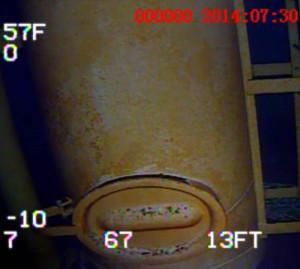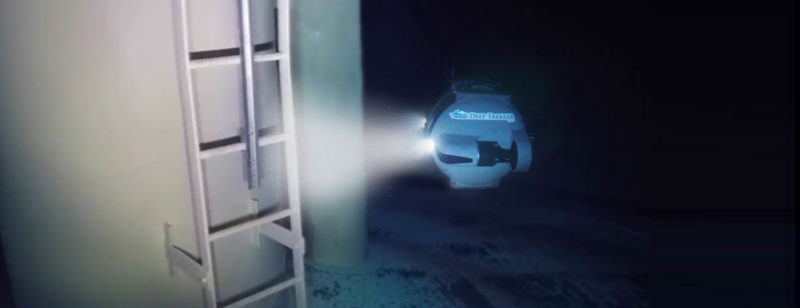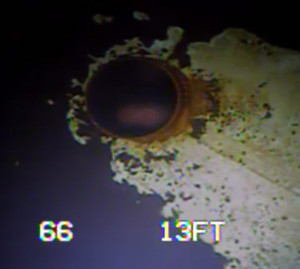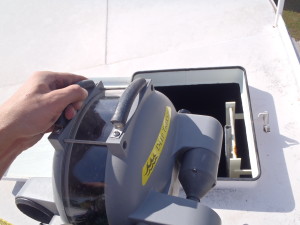Configure Now
Items in Your Cart0
0Items in Your Cart
Start building your packageShop Now
Viewing water tank inspection best practices with an underwater ROV (remotely operated vehicle) or underwater drone. Cities, municipalities, and contractors are using these underwater camera to document the condition of the tank and for any security issues - without shutting off services.
Reservoirs, water towers, and pipelines alike all play a major part in the water coming out of your tap. These systems all are required to be inspected regularly to ensure no harmful bacteria enter our homes.
Case Study: Monterrey Tank & Reservoir Repairs with Deep Trekker
Are you ready to start inspecting multiple water tanks a day? With less than a minute of setup, you can start completing more inspections now with the Deep Trekker DTG3 ROV systems.
To get you started, we have put together this list of some things to keep an eye out for during your inspections.
Many of our customers use the Deep Trekker grabber arm to retrieve these contaminants so they can be removed as soon as possible during regular inspections.
Using the 270-degree rotation of the camera, conduct quick sweeps of the roof and walls of the tank can be completed with ease.

Inspecting the outside of the tank is just as important as the inside. Luckily taking a look at the exterior of the tanks is pretty simple while you’re up there doing your internal inspection with the Deep Trekker ROV.
Many tanks will develop silt at the bottom, what is important is that it is managed to ensure it does not build up to start mixing with the water. Luckily with the Deep Trekker patented pitching system, instead of having a top or bottom thruster that would disturb the silt as you fly away from the bottom, the body and thrusters can be rotated away so not to disturb any silt throughout your inspection.

Below is a short list of areas to thoroughly inspect with the Deep Trekker DTG3 ROV.
The high definition and bright LED flood light illuminate your investigation areas even in the dark water tanks. Efficiently inspect the integrity of the entire system, with optional thickness gauge or laser scaler.

The laser scaler is an ideal tool for cracks, rust, and sediment to estimate size. Two lasers are positioned 25 mm apart above the camera, displaying on your handheld controller. With these reference points if issues of cracks or rust are found you can document the severity.
Another example where the Deep Trekker camera and laser scalers come in handy. With the digital video recorder, all of this evidence can be easily attached to your reports.
Talk to us about how our ROVs improve the safety, cost and speed of water tank inspections and cleanings
With the Deep Trekker ROV, no topside power is required, so you can complete your entire inspection from the top of the water tower if you so desire. Often times, these water tanks are very high – your safety is extremely important.
ROVs have the potential to improve the traditional approaches taken to water tank inspections. Our team has encountered the following benefits of using ROVs compared to traditional methods:
Easily bring the Deep Trekker ROV up to the top of the tower with you or hoist it up the side. With no generator required, you can complete all of your inspections from the launch site on top of the tower – or still remotely from your inspection vehicle if you prefer. The digital video recorder will document your entire dive, including the depth, water temperature, and heading to give directly to your client or to attach as documentation with your final report.
 Every county may have different requirements for proper water tank inspection, we hope that this short blog gives you a starting point to understand how you can ensure proper and safe inspections of our water storage facilities. Whether you are a municipality, private inspection company, someone wanting to start an inspection company, or just someone interested in investigating underwater mini ROVs like the Deep Trekker DTG3 provide unmatched maneuverability and will save you time and money.
Every county may have different requirements for proper water tank inspection, we hope that this short blog gives you a starting point to understand how you can ensure proper and safe inspections of our water storage facilities. Whether you are a municipality, private inspection company, someone wanting to start an inspection company, or just someone interested in investigating underwater mini ROVs like the Deep Trekker DTG3 provide unmatched maneuverability and will save you time and money.
US Underwater Services has utilized the DTG3 ROV for over 190 inspections during the last six months. -Jim Schrader, US Underwater Services
Interested in a Micro ROV for water tank inspection? Request a Quote today.
Finish the water tank inspection? Time to start cleaning ROV to clean your water tank!
November 3rd, 2025
At REPMUS 2025, Deep Trekker’s ROVs validated real-world mine countermeasure capabilities...
July 5th, 2025
Deep Trekker’s new Tampa facility brings faster ROV repairs, in-stock parts,...
June 11th, 2025
Equipped with sonar and DVL, Deep Trekker ROVs are helping SES...